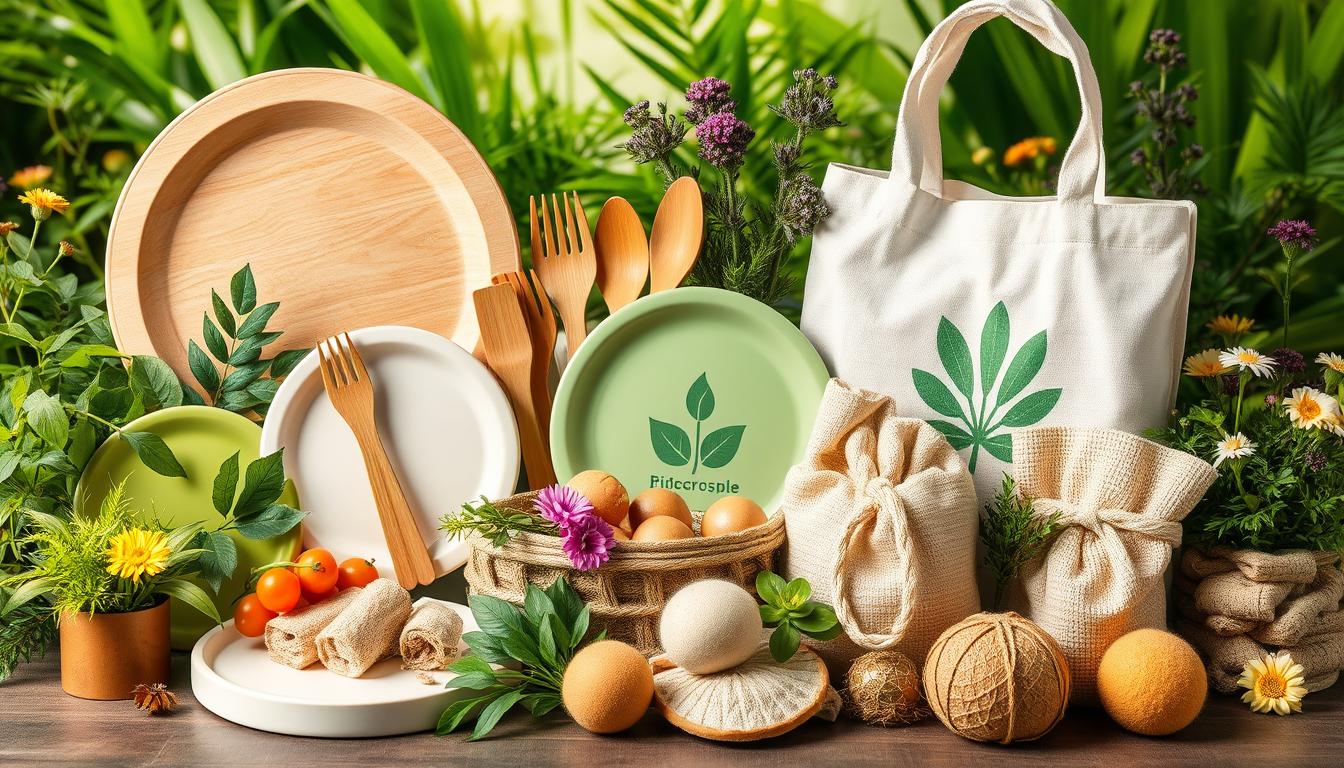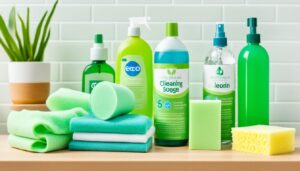Walking through my local park, I saw plastic bottles and wrappers everywhere. It made me think about how our choices affect the environment. Plastic doesn’t disappear; it stays in our world for centuries.
This thought made me want to learn more about biodegradable products. They are eco-friendly and help us live more sustainably. By using them, we can lower our carbon footprint and protect our planet.
It’s time for us to choose sustainable materials. As consumers, we can make big changes. This guide will teach you about biodegradable products and why they matter. It shows how small changes can lead to a greener future.
Key Takeaways
- Biodegradable products are crucial for reducing plastic waste and pollution.
- Sustainable materials like PLA, mushroom packaging, and bagasse provide eco-friendly alternatives.
- Transitioning to biodegradable options supports a healthier environment and promotes responsible consumer behavior.
- Understanding the differences between biodegradable and compostable materials is essential for informed choices.
- By integrating environmentally safe products into our lives, we contribute to the well-being of future generations.
Introduction to Eco-Friendly Living
Living in an eco-friendly way is crucial today. We can all help by changing our daily habits. This includes saving energy, cutting down on waste, and picking sustainable products.
Climate change displaces over 20 million people yearly. This shows how urgent it is to live green. By choosing eco-friendly habits, I can lessen my carbon footprint. This helps not just my area but also those affected by climate change.
For example, using energy-saving bulbs can cut my carbon emissions by 40 kilograms a year. Adding solar panels at home also helps, saving up to a tonne of carbon annually. Knowing that up to 25% of heating energy can leak through roofs and windows makes me look for ways to save energy.
Plastic waste is a big problem, so I use canvas bags and avoid single-use plastics. Fixing or repurposing items also helps reduce waste. This way, I contribute to a greener lifestyle.
In the end, eco-friendly living is not just a trend. It’s key to a healthier planet. By sticking to these habits, we can build a better future for everyone.
The Importance of Biodegradable Products
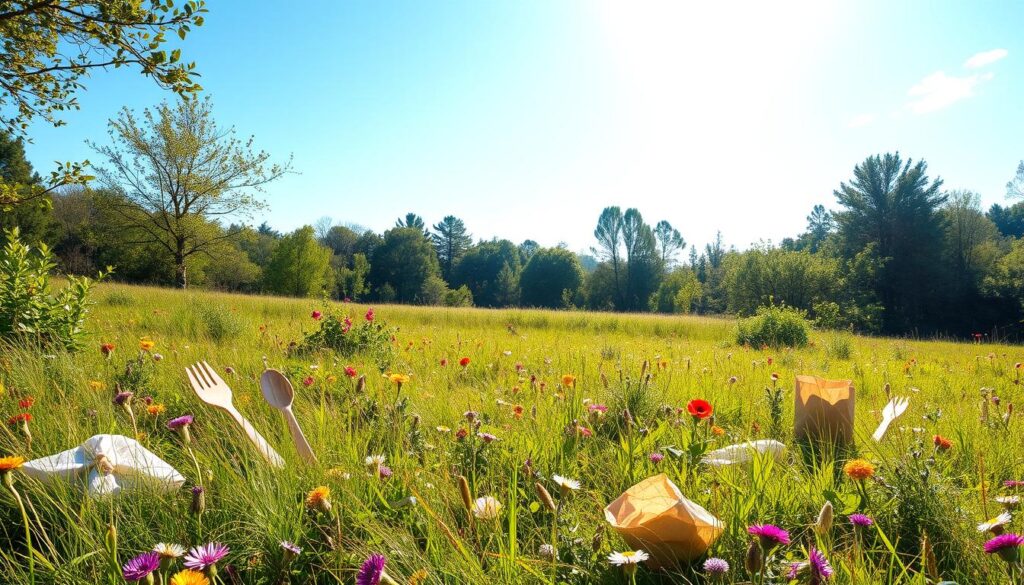
Biodegradable products are key to a cleaner, more sustainable world. They break down naturally, posing less risk to our ecosystems than regular plastics. This makes me think about making eco-friendly choices every day.
Understanding Eco-Friendly Alternatives
The move to green living solutions is growing fast. It’s because we need to fight plastic pollution. Biodegradable plastics cut carbon emissions by 500% compared to traditional ones.
The UK throws away over 30 million tonnes of household waste each year. A big part of that comes from kitchens and gardens. Biodegradable plastics can help reduce this, making our environment healthier.
Benefits of Choosing Sustainable Materials
Choosing sustainable materials has many advantages. Biodegradable products don’t harm marine life with microplastics. They break down quickly, improving soil health.
Big names like Coca-Cola are using bioplastics to show they care about the planet. This trend encourages more companies to follow, helping us all make a difference.
What Are Biodegradable Products?
Many people ask, what are biodegradable products? Simply put, they are items that break down naturally. This happens thanks to tiny living things like bacteria and fungi. Over time, they turn into something less harmful for our planet.
Using biodegradable products in our daily lives can greatly cut down on waste and pollution.
The Science Behind Biodegradation
Biodegradation is when materials break down into simpler things. It needs moisture, oxygen, and the right temperature. This process can take weeks to months, depending on the conditions.
For instance, some biodegradable plastics made from corn or potato starch need special places to break down. This ensures they don’t harm the environment.
This vs. Compostable Products
Biodegradable and compostable products are both good for the planet. But they’re not the same. Compostable items turn into soil nutrients in composting settings. Biodegradable products can break down in different places, including landfills.
In the U.S., a plastic is called biodegradable if it breaks down 60 percent in 180 days in a composting facility. Knowing the difference helps us make better choices every day.
Types of Biodegradable Products
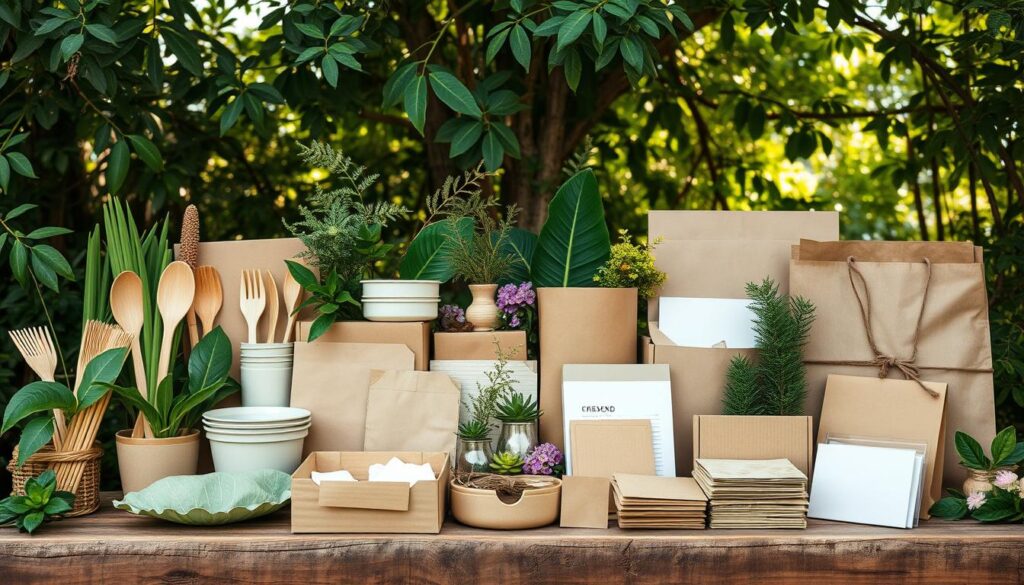
Exploring different types of biodegradable products opens up a world of sustainable options. There’s a big shift towards compostable materials that fit with eco-friendly living. I find fascinating varieties of plant-based biodegradable materials and paper-based products. They serve both practical purposes and environmental goals.
Plant-Based Biodegradable Materials
Plant-based biodegradable materials are made from renewable resources. They help the environment. Some examples include:
- Starch-Based Polymers: Commonly used in packaging, these materials break down naturally.
- Polylactic Acid (PLA): While widely used, PLA plastic requires specific conditions for effective biodegradation, often taking years in natural environments.
- Bamboo: This rapidly renewable resource needs less water and serves as an eco-friendly alternative to traditional plastics.
- Cork: Sourced from the Cork Oak, cork is lightweight and fully biodegradable, making it a practical choice for various uses.
- Tipa Bio-Plastics: Fully biodegradable and suitable for home composting, these products are commonly used in packaging.
- Mycelium: This material, derived from mushrooms and agricultural waste, finds applications in insulation and protective packaging.
- Hemp: Entirely biodegradable, hemp requires minimal resources to cultivate, making it a strong candidate for sustainable textiles.
- Jute: Compostable at home, jute is versatile in textile production.
- Wood: A renewable resource that breaks down naturally, wood is ideal for various applications.
- Areca Palm Leaf Products: Crafted from fallen leaves, these items are entirely natural and biodegradable.
Paper-Based Biodegradable Options
Paper-based products are some of the most prevalent eco-friendly items. They significantly reduce plastic consumption and have their own biodegradable properties. For instance:
- Typical paper takes about 2-5 months to biodegrade in the environment.
- Cigarette butts can linger for 1-12 years before fully breaking down.
- Leather shoes can take a staggering 25-40 years to biodegrade when discarded.
As the demand for sustainability rises, brands are increasingly adopting biodegradable alternatives. This reflects a broader commitment to eco-friendly practices. It’s exciting to see the evolution of biodegradable product offerings, from plant-based materials to innovative paper-based products.
| Material | Biodegradation Time | Source | Applications |
|---|---|---|---|
| PLA Plastic | Years under natural conditions | Manufactured from corn starch | Packaging, various products |
| Bamboo | Months | Fast-growing plant | Utensils, furniture |
| Cork | Years | Cork Oak tree | Flooring, wine stoppers |
| Tipa Bio-Plastics | Home compostable | Plant materials | Food packaging |
| Wood | Years | Renewable resource | Furniture, construction |
Biodegradable Packaging: A Sustainable Solution
In recent years, biodegradable packaging has become more popular as a green choice. People are now more aware of how packaging affects the environment. This has led to a higher demand for eco-friendly options.
The market for biodegradable plastic packaging was worth $4.65 billion in 2019. It’s expected to grow a lot. New ideas in this area aim to reduce harm to the environment while offering good alternatives to old materials.
Plant-Based Packaging Innovations
New materials like those from corn starch, sugarcane, and hemp are being used for biodegradable packaging. These materials are made from renewable sources and break down naturally. For example, cellulose film can decompose in 28 to 120 days, depending on its coating.
Using these materials helps reduce pollution caused by plastics made from petroleum. This is a big step towards a cleaner future.
Paper Packaging as an Eco-Friendly Alternative
Paper and cardboard are great examples of eco-friendly packaging. They can biodegrade in two to six weeks and are recyclable. This makes them reusable several times.
As waste levels rise, moving to biodegradable packaging is crucial. It’s a good choice for the 66% of consumers who care about the planet when they shop.
Benefits of Using Biodegradable Products
Using biodegradable products has many environmental benefits. They help reduce plastic pollution. This is important because traditional plastic production creates a lot of greenhouse gas emissions.
Reducing Plastic Pollution
Plastic waste is a big problem, with over five trillion pieces in oceans. Traditional plastics take up to 1,000 years to break down. But biodegradable products can decompose in just 18 to 36 months.
This fast breakdown stops harmful pollutants from getting into our environment. It helps keep our ecosystems clean.
Enhancing Soil Health Through Organic Decomposition
Biodegradable materials also improve soil health. As they break down, they add organic matter to the soil. This makes the soil better for growing plants.
Studies show that eco-friendly bio-polymers can decompose in weeks. They turn waste into compost, which is good for farming.
Supporting Sustainable Business Practices
Choosing biodegradable products is good for businesses too. It shows that a company cares about the environment. This makes them more appealing to customers who want to help the planet.
It also makes them more competitive in the market. This shift towards sustainability encourages companies to be more responsible for the environment.
| Benefits | Conventional Plastics | Biodegradable Products |
|---|---|---|
| Time to Decompose | Up to 1,000 years | 18 to 36 months |
| Impact on Soil Health | Minimal | Enhances nutrient availability |
| Plastic Waste in Oceans | 5 trillion pieces | Significantly less waste |
| Greenhouse Gas Emissions | High (up to 3 tons CO2 per ton produced) | Lower (0.5 tons for bio-polymers) |
Common Biodegradable Products You Can Use
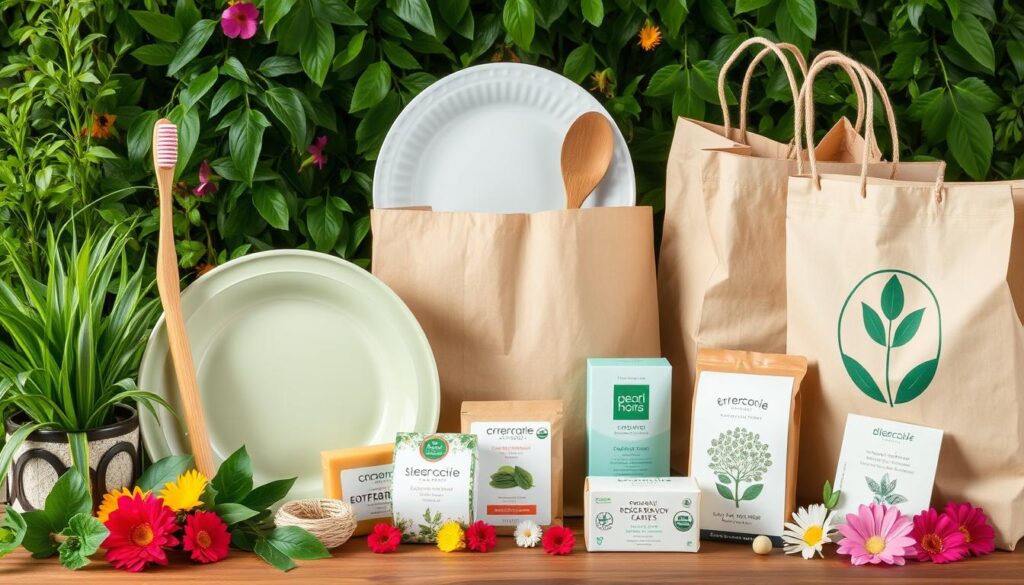
Using biodegradable products in my daily life is now easier and more fulfilling. I’ve learned that our choices affect the environment. So, I look for products that help reduce plastic waste and support green practices. Here are some excellent choices to consider.
Biodegradable Household Items
There are many biodegradable household items available. They offer eco-friendly alternatives to regular products. These items naturally break down, reducing harm to the environment. Here are some useful ones I’ve found:
- Biodegradable trash bags: Made from plants, these bags decompose faster than plastic ones, which take centuries.
- Biodegradable detergents: These eco-friendly cleaners use natural ingredients and come in sustainable packaging.
- Compost bins: Great for kitchen waste like vegetable peels and food scraps, turning them into garden fertilizer.
- Plant-based compostable tableware: Perfect for parties, these items quickly decompose, cutting down on landfill waste.
- Natural cleaning sponges: Made from sponge or loofah, they naturally break down and are better than synthetic ones.
Eco-Friendly Personal Care Products
Switching to eco-friendly personal care products has been a rewarding change. Many of these products are effective and biodegradable. Here are some items I choose regularly:
- Bamboo toothbrushes: A green alternative to plastic toothbrushes that break down over time.
- Biodegradable sanitary products: Brands are making menstrual products from organic materials, reducing plastic waste.
- Shampoo bars: These solid bars have minimal packaging and cut down on plastic from bottles.
- Natural body scrubs: Made with biodegradable ingredients, they’re a guilt-free way to relax.
- Eco-friendly soap bars: Choosing bar soap over liquid in plastic bottles makes a big difference in reducing waste.
Switching to biodegradable household items and eco-friendly personal care products is part of a bigger movement towards sustainability. As more companies meet consumer demand, finding and using these alternatives becomes easier and more environmentally friendly.
| Product Type | Benefits | Biodegradation Time |
|---|---|---|
| Biodegradable Trash Bags | Reduces plastic waste | 2-6 months |
| Biodegradable Detergents | Minimizes environmental impact | Varies by formulation |
| Bamboo Toothbrushes | Natural and compostable | 6 months to 2 years |
| Compost Bins | Turns waste into compost | Months to years |
| Shampoo Bars | Reduces plastic use | Months to years |
The Role of Consumers in Promoting Biodegradable Products
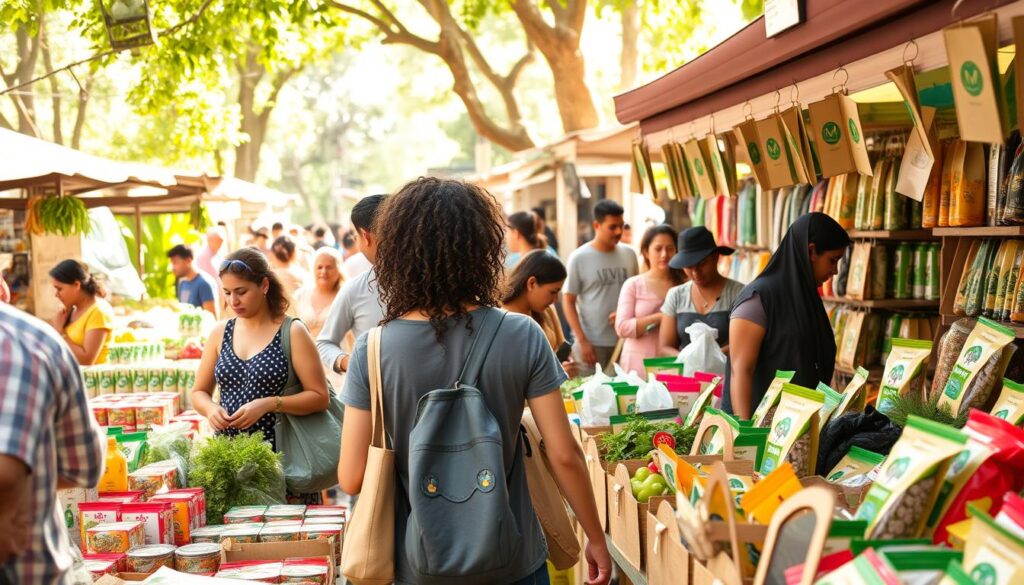
As I explore eco-friendly living, I see how my choices matter. My buying habits can push the market towards a greener future. Many, especially Millennials, are now looking for sustainable products. This shows a big increase in people wanting to buy green over traditional items.
Making Informed Purchasing Decisions
Even though more people want eco-friendly products, only 26% of us choose them often. This shows a big gap between what we want and what we do. Yet, 65% of us want to buy from brands that care about the planet. By picking sustainable products, I help brands that support our planet.
Educating Others About Sustainability
With knowledge, I can teach others about green alternatives. Talking to friends, family, and community about biodegradable products can make a big difference. Many people don’t know how their choices affect the environment. Learning about the harm of single-use plastics can motivate us to choose biodegradable ones.
Challenges in Biodegradable Product Usage
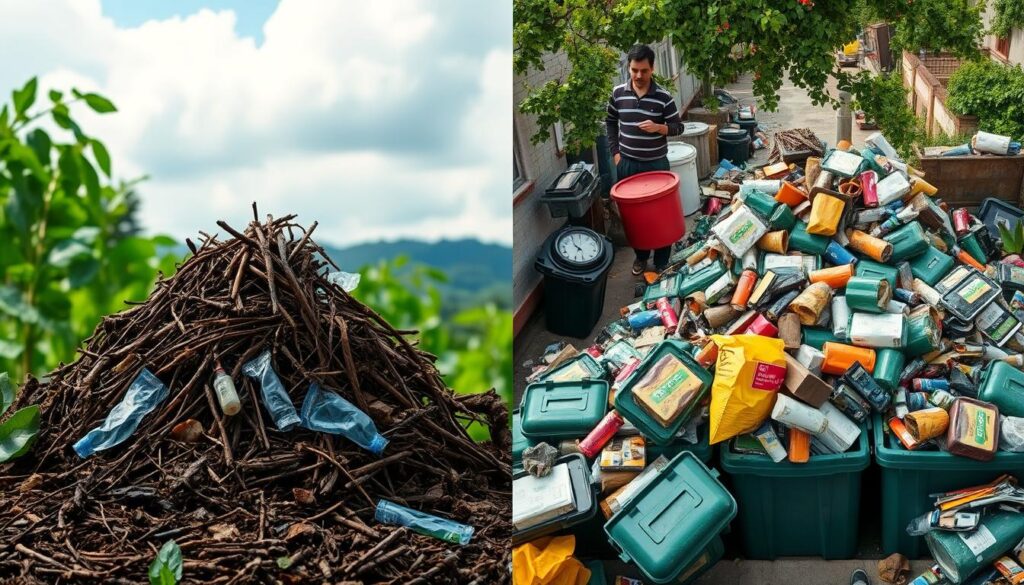
It’s key to know the challenges of biodegradable products to make smart choices. Many myths about biodegradability confuse us, making it hard to know what’s truly eco-friendly. For example, people think all biodegradable materials break down fast in any place. But, things like temperature, moisture, and microbes really affect how fast they decompose.
This confusion stops some from choosing sustainable options.
Misunderstandings About Biodegradability
Many think biodegradable products are a quick fix for the plastic problem. They believe all biodegradable plastics will easily break down in landfills. But, most need special conditions, like industrial composting, to really break down.
Learning more about biodegradable products can help clear up these myths.
Availability and Cost Concerns
Finding eco-friendly products is harder than finding regular ones. This makes people stick to traditional plastics. The cost is also a big issue, as these products are often pricier.
As I shop, I try to balance these factors. Making these products more available and affordable would help us switch to biodegradable options.
How to Transition to Biodegradable Products
Switching to biodegradable products can seem hard at first, but it’s very rewarding. More people are looking for brands that care about the planet. I’ve found some useful tips to help make this change easier.
Practical Tips for Everyday Living
Adding biodegradable items to my daily routine is easy with a few steps. Here are some tips that have helped me:
- Start Small: Begin by replacing a few items in your home with biodegradable ones, like compostable trash bags or bamboo toothbrushes.
- Read Labels: Learn to spot biodegradable products by looking for specific labels.
- Buy in Bulk: Buying biodegradable products in bulk can cut down on packaging waste.
- DIY Options: Making your own cleaning products can help avoid plastic containers.
- Educate Myself: Keep up with the benefits of biodegradable products by reading blogs and following brands.
- Share Knowledge: Talk about using biodegradable products with others to start conversations about being green.
Finding Eco-Conscious Brands
Finding brands that care about the environment is key. Here’s how to find them:
- Research Online: Use the internet to find eco-friendly brands and compare them.
- Visit Local Stores: Look for local shops that sell sustainable products, like biodegradable ones.
- Social Media Exploration: Follow brands on Instagram or Facebook to see their green efforts.
- Connect with Communities: Join local groups or online forums that talk about eco-friendly brands.
- Check Certifications: Look for brands with eco-friendliness certifications to ensure they meet green standards.
By following these steps, I’ve seen how using biodegradable products helps the planet. It also encourages a greener lifestyle. Choosing brands that care about the environment and using practical tips can make a big difference in our daily lives.
Comparing Biodegradable Products to Other Eco-Friendly Options
Looking into eco-friendly products, we see big differences between biodegradable and recyclable items. Both aim to lessen harm to our planet. But knowing their unique strengths and weaknesses helps us make better choices.
Biodegradable vs. Recyclable Products
There’s often confusion about biodegradable and recyclable products. Biodegradable items like paper and cotton break down with the help of tiny organisms. This can take 3 to 6 months, helping to reduce landfill waste.
On the other hand, recyclable materials like cardboard can be used up to 20 times. They need 75% less energy to make than new items from raw materials.
It’s key to understand how these materials decompose. Compostable goods turn into soil, but biodegradable items might break down into harmful microplastics. This makes us question if biodegradable products are truly eco-friendly.
Understanding Sustainable Alternatives
There are more options beyond biodegradable and recyclable. Compostable items like food waste and yard trimmings decompose fast and make soil better. Sadly, about 42% of people don’t know how to dispose of these items correctly.
This shows how crucial clear labels and education are. Whether choosing biodegradable or recyclable, our goal is to help the planet.
Future of Biodegradable Products
The world of biodegradable products is changing fast. This change comes from people wanting more sustainable options and new materials. We’re moving towards products that are better for our planet.
Innovations in Biodegradable Materials
New materials like algae, mushroom mycelium, and waste from farms are becoming key for biodegradable plastics. These new materials offer more than what old options like cornstarch did. They might even have special properties like fighting off germs and protecting against sunlight.
Things like EcoPure® help plastics break down faster without losing strength. This helps us use these materials in a way that’s good for the environment. New ways of making these plastics, like 3D printing, are making them cheaper and more accessible.
Legislation and Consumer Trends
Laws and bans on single-use plastics are pushing for more biodegradable products. As people learn more about the environment, they want products that are better for it. This change in what people want is helping companies choose greener options.
Working together, companies, tech firms, and waste managers are making biodegradable plastics better. Programs that teach people about being green are also important. They help us all use biodegradable products more.
| Innovation Type | Description | Potential Benefits |
|---|---|---|
| Novel Raw Materials | Algae, mushroom mycelium, agricultural waste | Sustainable and multifunctional alternatives |
| EcoPure® Additive | Accelerates biodegradation of plastics | Durable yet environmentally friendly |
| 3D Printing | Scalable production techniques | Cost-effective and efficient manufacturing |
| Government Policies | Support for biodegradable products | Increased research and market adoption |
| Consumer Awareness | Heightened demand for sustainable products | Motivation for businesses to innovate |
Conclusion
Embracing biodegradable products is key for a greener future. The guide shows how bioplastics have grown in popularity. It also highlights the need for everyone to act together.
Choosing biodegradable items helps reduce plastic waste. This includes less microplastics in oceans and lower carbon emissions. Every small step helps.
Switching to biodegradable materials can greatly reduce waste. This is especially true for retail and food packaging. Making eco-friendly choices is a big step towards a healthier planet.
Supporting companies that focus on the environment is crucial. This helps create a better future for all. It’s not just a trend; it’s a commitment to our planet’s well-being.
Innovation in biodegradable materials is vital for our progress. We need to work together to make better choices. This way, we can all contribute to a greener world.
FAQ
What are biodegradable products?
Biodegradable products can break down naturally over time. They are made from materials that don’t harm the environment. This makes them a good choice for those who want to reduce waste.
How do biodegradable products differ from compostable products?
Both can break down naturally, but compostable products need a special environment to do so. Biodegradable items can break down in many places, but might not fully decompose without the right conditions.
Why are biodegradable products important for the environment?
They help fight plastic pollution and reduce landfill waste. Using biodegradable products supports sustainable practices. This helps keep our planet healthy.
What types of biodegradable products can I use in my daily life?
You can use biodegradable trash bags, cleaning supplies, bamboo toothbrushes, and natural shampoos. These items help you live more sustainably.
Are biodegradable products more expensive than traditional products?
Some biodegradable products might cost a bit more. But, their environmental benefits make them worth it in the long run.
How can I support the use of biodegradable products?
Support them by choosing eco-friendly options when you shop. Also, tell others about the benefits of sustainable products.
What challenges do biodegradable products face in the market?
They face issues like misinformation and concerns about availability. Also, some people think they’re not as good as traditional products. But, these problems can be solved with education and awareness.
What are some tips for transitioning to biodegradable products?
Begin by replacing a few items with biodegradable ones. Start with something simple like compostable bags. Then, look for more eco-friendly products as you go.
What is the future of biodegradable products?
The future looks bright with new materials and technologies. More people want sustainable options, and laws are supporting this trend. This will boost demand in many industries.
Source Links
- The Ultimate Guide to Biodegradable Packaging Materials: Environmentally Friendly Alternatives to Plastic
- 13 Biodegradable Materials for an Eco-Friendly Future 2024
- 40 Ways to Be More Eco Friendly in 2024 | GreenMatch
- The Ultimate 20 step Guide to Eco-friendly Living | Good Energy
- What is an eco-friendly product ?
- The 7 Benefits Of Biodegradable Bags | Polystar Plastics ✓
- Biodegradable materials: what is it, what is it used for and practical examples – Primebiopolymers
- 11 Biodegradable Materials That Will Save The Planet
- Biodegradable Products
- 15 Biodegradable Products The Materials Make Eco-friendly – renouvo
- IEI Plastics – Did you know Types of Biodegradable Plastics and Their Applications?
- #34: Biodegradable Products with Susanna Carson | Sustainability Defined
- What is Biodegradable Packaging? Process, Materials, and Benefits
- What is Biodegradable Packaging? Definition&Benefits | TIPA
- The top 10 must-have sustainable packaging solutions
- 7 Biggest Advantages of Biodegradable Plastics | Weavabel
- The Truth About Bioplastics
- Make the Earth Safer: A Huge List of Biodegradable Products
- 9 Biodegradable Packaging Materials That Can Replace Plastic
- The Best Eco-Friendly Alternatives for the Plastic in Your Life
- The Elusive Green Consumer
- Why Do Consumers Switch to Biodegradable Plastic Consumption? The Effect of Push, Pull and Mooring on the Plastic Consumption Intention of Young Consumers
- Ways to Create a World Without Waste: Biodegradable Products for Consumers
- Challenges and opportunities of biodegradable plastics: A mini review
- 7 Creative Ways to Embrace Biodegradable Alternatives to Plastic that Make a Difference
- New process makes ‘biodegradable’ plastics truly compostable – Berkeley News
- The differences between recyclable, compostable and biodegradable packaging
- Biodegradable vs Compostable Materials: What’s The Difference?
- Future Trends in Biodegradable Plastic Technology
- Biodegradable Future | Home
- What Is Biodegradable Plastic Packaging And Why Is It Important?
- Bioplastics for a circular economy – Nature Reviews Materials

